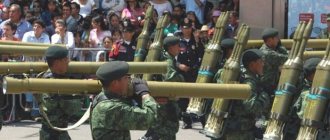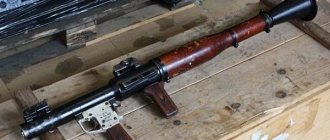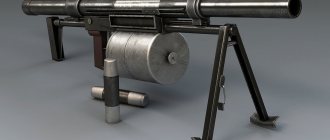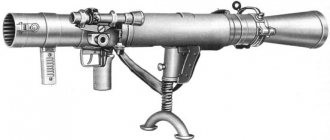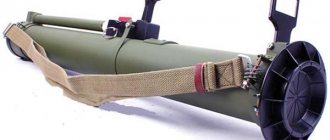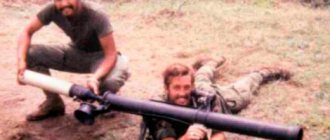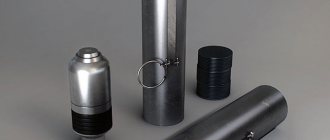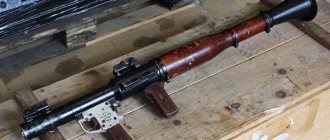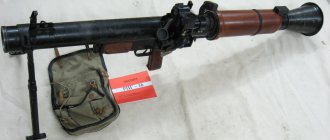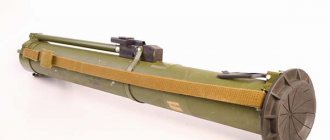Baryshev automatic hand grenade launcher. Grenade launcher without recoil
The Soviet school of weapons development was one of the best in the world, but not all samples managed to reach the prototype stage to mass production. Often promising systems could not make their way due to the inertia of the existing military leadership, which was reluctant to accept promising systems. Some experimental samples had to go a very long way to finally see the light, but this happened at a different time, and sometimes in other countries. And if the AEK-971 assault rifle has found a rebirth these days already in Russia, then Baryshev’s automatic hand-held grenade launcher will be produced in the homeland of its designer - in Belarus.
Baryshev's automatic hand grenade launcher, also known under the designation ARGB-85, can be considered one of the lucky ones who managed to go all the way from an experimental model to a production model, however, this entire path took almost more than 30 years. This updated grenade launcher is being prepared for production in Belarus at the Belspetsvneshtekhnika enterprise.
ARGB - Barashev automatic hand grenade launcher. It is designed to destroy both single and group targets with fragmentation grenades at a distance of up to 1000 meters. Anatoly Filippovich Baryshev became interested in the development of small arms back in the 1950s, having since then created a whole line of weapons. His automatic hand-held grenade launcher was part of a small arms complex with a new locking unit created by A.F. Baryshev. The complex included: AB-5.45 assault rifles chambered for 5.45x39 mm caliber and AB-7.62 submachine guns chambered for 7.62x39 mm caliber; AVB automatic rifle chambered for a 7.62x53 mm rifle-machine-gun cartridge; 12.7 mm KPB heavy machine gun and 30 mm ARGB automatic hand grenade launcher for the standard VOG-17 round. All weapons in this line were united by the presence of automatic fire. The thing is that the main feature of this line was the original principle of operation of the locking device, which was aimed at reducing recoil and increasing the accuracy of fire when firing in bursts.
The most common small arms are those equipped with gas engines (these are the Kalashnikov assault rifle and the American M16 assault rifle). At the same time, in Baryshev’s system everything worked on recoil energy. His weapon used a semi-blowback action for operation. All samples of his new small arms complex were distinguished by the presence of a very unique locking unit, which was created according to a single design. The peculiarity was that, along with its main function, it also provided partial absorption of the recoil energy of the weapon when firing, since the bolt parts - the bolt frame, the combat cylinder, the bolt frame and the locking lever were not rigidly connected to each other. For this reason, a significant part of the recoil at the moment of the shot was used to sequentially set these parts in motion, which, in turn, due to the collision of the moving elements and the extension of their interaction over time, significantly (at least 2-3 times) reduced the recoil force. Reducing the recoil force that acted on the shooter at the moment of firing made it possible not only to increase the accuracy of automatic fire in continuous bursts, but also at the same time to significantly reduce the weight of the weapon - by the same 2-3 times.
As noted above, the interaction of the moving parts of the weapon extended over time could dampen a significant part of the impulse, significantly increasing the stability of the weapon in the hands of the shooter when firing in bursts. The dispersion of an assault rifle designed by Baryshev (AB) when firing in bursts was immediately 12 times less than that of the AK-74. This result could only be described in one word – fantastic. But you have to pay for everything in the world. In this case, we had to pay for the reliability of the system. During intense shooting from a weapon, the chamber became contaminated with combustion products, as well as small particles of varnish from the cartridge cases. When firing, the chamber becomes hot, and the cartridges literally begin to “stick” to its walls. In such conditions, the Kalashnikov assault rifle continues to work uninterruptedly - dirt is not a hindrance for the gas exhaust mechanism, but the automatic battery begins to malfunction. It is for this reason that Baryshev’s shooting system, despite participating in a large number of competitions since the 60s of the last century, has largely remained an experimental system forever.
At the same time, there is one type of automatic weapon that does not provide for non-stop firing - this is a grenade launcher. For example, the standard AGS-17 ammunition consists of three boxes, a total of 87 rounds. In this regard, Baryshev’s system is truly out of competition. According to reviews from testers of his ARGB-85 automatic hand grenade launcher, the recoil from it did not exceed the recoil from conventional under-barrel grenade launchers, which made it possible to hit targets located at a distance of up to half a kilometer from the shooter with rapid fire from the hands. At the same time, firing from the AGS-17 was only possible from a heavy machine. It is no coincidence that GRU special forces and KGB border troops showed interest in the ARGB-85, which weighed about 15 kg, but the rapid collapse of the Soviet Union stopped the development of a hand-held grenade launcher, freezing its fate for a long time. At the same time, at various times in the Czech Republic and Ukraine, attempts were made to launch unlicensed production of ARGBs, but Anatoly Baryshev managed to patent his scheme and was able to stop them.
For indirect fire, the ARGB could be equipped with an optical sight with a side level and a protractor mechanism, a folding stock-opener and a removable bipod. In terms of its weight and size characteristics, the Baryshev grenade launcher was significantly ahead of all known systems of automatic hand grenade launchers. Weighing 15.3 kg, its total length did not exceed 950 mm, and with the butt folded - 700 mm. The magazine capacity was 5 shots, the rate of fire was 350 rounds per minute, and the initial speed of the grenade was 185 m/s.
Thanks to the wide range of 30-mm rounds, the ARGB could be used as a powerful offensive fire support weapon for motorized rifle units. The grenade launcher was indispensable as a means of direct fire support for infantry, especially in offensive combat, as well as in combat operations in difficult conditions: in the mountains, in urban areas, in trenches. Reducing the weight of the grenade launcher, among other things, made it possible to reduce the crew from 2-3 to one person, sharply increasing its maneuverability.
The ARGB fully revealed the advantages of the Baryshev's semi-blowback system, allowing the shooter to conduct fairly effective automatic fire even from unstable positions while moving and standing from the hip. According to the test participants of this hand-held grenade launcher, standing from the hip it was possible to hit a truck located at a distance of 400 meters with the second or third shot. When firing from an ARGB, the recoil at the moment of the shot was felt by the shooter no more than when firing from a 40-mm GP-25 under-barrel grenade launcher, which was installed on machine guns. At the same time, when firing from stable positions (lying down from a bipod), a significant part of the weapon’s recoil was effectively dampened by the shock absorber built into the butt, thus increasing the accuracy of fire. Experts considered the indisputable advantages of the Baryshev grenade launcher to be the elimination of a gas engine (gas piston, gas chamber, gas outlets). This significantly reduced the cost and simplified the design of the weapon, allowing for improved performance characteristics.
Baryshev's automatic hand grenade launcher, which never entered service and did not go into mass production in the USSR, became the basis for the development of new Belarusian weapons. On June 12, 2022, the Belarusian online news portal tut.by reported that the Belspetsvneshtechnika enterprise is preparing for mass production of a unique assault grenade launcher, which should go into service with Belarusian special forces units.
According to the designer of the Belspetsvneshtekhnika enterprise, Igor Vasilyev, the ergonomics of the experimental automatic grenade launcher designed by Baryshev has been significantly improved. In particular, thanks to the use of composite materials and titanium, the weight of the weapon was reduced to 8 kg. This allows the soldier to use this hand grenade launcher as a classic small arms (there is no need for a special machine).
The new Belarusian modification of the ARGB provides for the installation of a thermal imaging sight on it, which will allow the grenade launcher to be used in conditions of difficult visibility and at night. It is also possible to install an optical sight and a laser target designator on the hand grenade launcher. According to Belarusian developers, with the help of modern sighting devices, the shooter will be able to confidently hit targets with the first shots at a distance of up to 1200 meters.
The grenade launcher, as before, uses 30-mm ammunition from the AGS-17 “Plamya” mounted automatic grenade launcher: VOG-17M, VOG-17A, VOG-30 and GPD-30. The main feature of the new Belarusian development is the following: the grenade launcher can still be fired in bursts directly from the hands. According to Igor Vasilyev, the recoil of the grenade launcher is now comparable to the recoil of shots from a conventional 12-gauge hunting rifle. According to a representative of Belspetsvneshtekhnika, in the serial version, the automatic manual grenade launcher will be equipped with either a magazine designed for 6 shots, or a belt for 29 shots. Representatives of the Belarusian company say that prototypes of the updated hand grenade launcher have already been tested by Belarusian special forces soldiers and, based on the test results, they received positive feedback about the new product.
Sources of information: https://oruzhie.info/granatomety/841-argb https://tvzvezda.ru/news/opk/content/201706190827-v5t3.htm https://warspot.ru/9274-belorusskiy-spetsnaz-vooruzhat -shturmovym-granatomyotom https://zonwar.ru/granatomet/ru4nie/ARGB.html
The rapid-fire 20th century and its weapon legends
It is believed that the twentieth century was the era of legendary gunsmiths. This may be true, although they owe most of their fame to two sad circumstances. The first of them is the increased information saturation, the emergence of such types of means of mass notification (and fooling too), such as radio, television and the worldwide computer network. But this factor cannot explain the popularity of the surname “Kalashnikov” in different countries, including those where the majority of the population does not know how to read. And this means, of course, not Lermontov’s character, the merchant, but his rapid-fire namesake. AK's circulation exceeds the number of printed copies of any book. Of course, Baryshev is known much less than Kalashnikov; an assault rifle of his design is not yet mass-produced. The reasons for the lack of worldwide fame have nothing to do with shooting and technological characteristics. The popularity of this model is yet to come; perhaps its design was simply ahead of its time.
main idea
The main enemy of rapid fire weapon accuracy is related to its main advantage. When firing in bursts, every fighter knows that, at best, the first bullet hits the target, the rest fly at random. The reason for this is the recoil, which throws the barrel up and down, left and right. If this negative factor is somehow neutralized, shooting will immediately become more accurate. Anatoly Baryshev’s machine gun is characterized by extremely low (three times) recoil. The designer made the main invention of his life a long time ago, but its implementation in practice took a lot of time. In 1962, Baryshev himself, without orders from above, as a matter of personal initiative, began work on a special mechanism for locking the barrel bore. The path was long, there were plenty of ill-wishers, including among specialists who realized that this proprietary system, if successful, could become revolutionary. This result was not desirable for everyone. One day it got to the point that all the explorer’s developments were ordered to be destroyed within two days. Fortunately, this order remained unfulfilled.
Further development of the concept
If the recoil is less, this means that the weapon can, in principle, fire heavier ammunition, which creates conditions for the use of large calibers and even grenades. The first design presented to the high commissions was the Baryshev 7.62 54 mm assault rifle (cartridge length), then the complex with a single concept was replenished with a rifle of the same caliber and a bicaliber system, including a 12.7 mm machine gun and an AGB-30, an automatic grenade launcher firing 30 mm grenades. Individual weapons acquired firepower previously uncharacteristic of this class.
The invention needed documentary confirmation of priority, however, departmental tensions and other sad realities of late Soviet society did not allow the author to become the owner of a certificate. In 1992, the patent was nevertheless received (No. 2002195), but the outstanding achievement remained unclaimed.
The essence of the invention
Recoil occurs for two reasons. Firstly, everyone knows Newton’s third law from school, which, as applied to weapons, states that the acceleration of a bullet causes an opposite reaction in the gun, carbine or machine gun. The bullet is much lighter, but it also flies out quickly. The second reason is the operation of a mechanism that instantly reacts to a shot and performs its work in a short period of time. If nothing can be done with the underlying natural laws, something needs to be done to lock the barrel, the designer decided. The Baryshev machine differs from other systems precisely in its smooth, “extended” work cycle over time. To achieve this goal, the elements of the locking unit are connected in series, and in each of them the recoil impulse is partially damped. Such depreciation leads to stabilization of the barrel position and a significant improvement in accuracy, that is, exactly the result that every shooter dreams of.
Flaws
Given such an important advantage as the low level of recoil in combination with the relative simplicity of the device, due to the absence of a gas outlet channel in the design, it is impossible to objectively evaluate the Baryshev assault rifle without mentioning its shortcomings. The bolt group turned out to be too massive for the overall “flimsy” (according to one of the testers) impression of the sample. It is difficult to predict how impacts of this unit on the receiver will affect it. An insufficient level of reliability was noted by participants in early tests, but it is quite possible that today this shortcoming has already been eliminated.
Some complaints were caused by the delay between pressing the trigger and the first shot, but nothing can be done about it, this is a fundamental issue, and the low recoil is due precisely to a certain slowness of the entire locking mechanism.
The beginning of the inventor's career
This gunsmith is often called self-taught, obviously referring to his lack of a higher education diploma. Yes, indeed, Anatoly Baryshev did not graduate from college or university. He created his machine gun, however, not relying on natural ingenuity or folk instinct. The designer was born in Istra, near Moscow, in 1931, then graduated from the Kaliningrad Technical School, where, obviously, the level of knowledge was no worse than in modern universities (at least in special subjects). Work at weapons factories, whose main specialists were A.M. Lyulka and V.G. Grabin, contributed to gaining experience, which a real specialist cannot do without. Already undergoing military service from 1951 to 1954, the young man made rational suggestions when designing shooting simulators, invented and created. In 1952, a twenty-year-old soldier realized that his goal was an assault rifle of his own design. It was no longer possible to stop Baryshev.
Promising sample
Undoubtedly, this machine has advantages and advantages that determine its future prospects. Low recoil, high rates of accuracy and shooting accuracy, technological simplicity and a high degree of unification with the main model of small arms of the Russian and many other armies of the world can become an incentive to launch mass production of AB. However, there are also limiting factors, including the need for serious investment. The budgetary costs required for the introduction of a new model are currently not a priority for ensuring the country's defense; today, it is much more important to improve the nuclear shield and air defense systems, which directly ensure security on a global strategic scale.
Most likely, Baryshev’s assault rifles will be manufactured primarily to equip special units with them, at least at the first stage. They are lighter than Kalashnikovs and meet all the requirements for this type of weapon (even the stock is initially folding).
Mass rearmament of a new type of rifle in the Soviet army took place in the post-war years, when PPSh assault rifles, produced by the industry in the amount of six million, were gradually replaced by AKs.
Tactical and technical data
The quality of a weapon is objectively assessed by digital indicators, although they cannot always describe all the features and advantages of the sample. Nevertheless, here they are, presented for convenience in table form:
| Name | Automatic AB-7.62 | Carbine AVB-7.62 |
| Caliber, mm | 7.62 x 39 M43 | 7.62x54R or 7.62 x 51 NATO standard |
| Total length (stock unfolded), mm | 960 / 710 | 1000 / 750 |
| Barrel length, mm | 415 | 455 |
| Weight of unloaded weapon, kg | 3,600 | 3,900 |
| Rate of fire rds/min. | 750 | 750 |
| Store capacity, pcs. | 30 | 10 or 20 |

